Heywood Corporation Tramways
History
The first tramway in Heywood, which opened in March 1884, was not owned by the local authority (Heywood Borough), but by a company — Manchester, Bury, Rochdale and Oldham Steam Tramways Limited — which following restructuring in 1888, became the Bury, Rochdale and Oldham Steam Tramways Company. The Heywood tramway formed part of the company's line between Bury and Rochdale, which had been built to a gauge of 3ft 6ins, and was operated by steam traction.
Under the Tramways Act of 1870, local authorities were empowered to take over tramways within their municipal boundaries 21 years after the passing of the parliamentary act that enabled their construction. In the case of Heywood, this was the Manchester, Bury and Rochdale Tramways (Extension) Order of 1882, which had been authorised on the 12th July 1882 under the umbrella of the Tramways Orders Confirmation (No 3) Act, 1882.
Ahead of the looming 21-year date (in Heywood's case this was 1903), discussions were held between the various authorities as to how they would dismember and operate the tramway, as well as convert it to overhead electric traction. In the end, each authority decided to acquire its own powers to reconstruct the tramway within their respective areas, Heywood's being granted on the 8th August 1902 by the Heywood Corporation Tramways Order, which was passed into law under the Tramways Orders Confirmation (No 2) Act, 1882. All three corporations chose to convert the steam tramway to standard gauge.
Although Heywood Corporation wished to own and thus control the tramways within the municipality, it was clear that such a small system would never be viable if operated independently, so negotiations were opened at an early stage with Rochdale and Bury Corporations, as would-be operators. Unfortunately, agreement was a long time coming, which was to have significant consequences for Heywood.
The corporation effectively became a tramway owner on the 24th February 1904, when a binding agreement was reached between several local authorities and the BR&OSTCo, to acquire the tracks and assets of the company within the various municipalities, though it would not be until the 13th October 1904 that the transaction was finally completed. The agreement allowed those authorities who were building electric tramway systems (primarily Bury and Rochdale Corporations) to gain access to the tracks and thus progress the work of converting the tramway to standard-gauge overhead electric traction; during this process, the company continued to operate steam trams.
Steam services between Bury and Heywood were withdrawn on the 7th March 1904 to enable Bury Corporation to commence reconstruction of the line between Bury and its border with Heywood at Heap Bridge. Whilst this was in no way a surprise, what followed certainly was, when on the 10th June 1904, Rochdale Corporation commenced reconstruction of various lines within the town, which unexpectedly (at least as far as Heywood Corporation was concerned), severed the connection between the town and the BR&OSTCo steam depot in Rochdale, thus depriving it of all tram services.
Although Bury Corporation electric cars had commenced running to Heap Bridge two months earlier (on the 21st April 1904), Heywood Corporation was determined not to enter into an operating agreement that was not to its liking, so for the time being the town remained without a tram service of any kind. The corporation eventually decided to remedy the situation by purchasing several former-BR&OSTCo steam trams and trailers from Rochdale Corporation, commencing its own steam services on the 20th December 1904, presumably with dispensation to do so from the Board of Trade. Although the corporation now operated steam services through to its eastern boundary with Rochdale Corporation (at Heywood Cemetery), the latter's electric cars did not reach there until the 13th April 1905, so passengers were forced to walk between the cemetery and Sudden (the temporary RCT terminus) for nearly four months.
Agreement on electric operation was eventually reached with both Bury and Rochdale Corporations in August and September 1905, respectively, with conversion to electric traction beginning on the 21st August 1905. The last steam tram ran on the 20th September 1905, with the first electric tramcar running through from Bury to Heywood on the 17th December 1905 (and onto Hopwood from the 1st March 1906), and the first electric car from Rochdale to Heywood on the 20th December 1905. The operating agreement with Bury Corporation was for three years (expiring on the 4th December 1908) and with Rochdale Corporation for two years (expiring on the 11th January 1908).
Although Heywood Corporation was no longer a tramway operator, it still played a very active role in tramway affairs, maintaining the track (until 1919) and setting service standards. During the first years of electric operation difficulties still persisted with Rochdale Corporation, and another two years were to pass before through running commenced between Bury and Rochdale (on the 1st August 1909). The through-running agreement, as well as new operating leases received parliamentary approval on the 16th August 1909, as part of the Heywood Corporation Act, 1909.
Like many tramways, Heywood Corporation's emerged from the Great War with a significant backlog of maintenance work. Although much track improvement took place, by the mid-1920s, the tramways were making an annual loss, primarily due to unregulated bus competition. Despite the losses, the corporation was happy to enter into an agreement with Manchester Corporation Tramways for the latter to finance and build a new line from Middleton to Hopwood, which opened on the 19th May 1928.
Following further losses and pressure from Rochdale, agreement was reached in May 1932 on replacing the trams with buses, Rochdale ceased all tramway services to Heywood on the 2nd July 1932, with Bury following suit on the 19th February 1933. The last tram of all in Heywood, operated by Manchester Corporation Tramways, ran on the 1st May 1934, following which the Middleton route, only 6 years old, was closed.
In the steam tram era, the Heywood system totalled 4.33 route miles, and in the electric era, 5.18 miles. The system was centred on Heywood Market Place, with lines running westwards to meet the tracks of Bury Corporation at Heap Bridge, and eastwards to meet the tracks of Rochdale Corporation at Heywood Cemetery. A branch also ran southwards to Hopwood, which from 1928 was connected to the newly built MCT line from Middleton.
Uniforms
Heywood Corporation only operated steam tramway services for a matter of 9 months — from 20th December 1904 to 20th September 1905 — following Rochdale Corporation's abrupt severance (on 10th June 1904) of the service provided by the BR&OTCo.
Photographs clearly show that Heywood Corporation continued the practice of its immediate predecessor in not issuing uniforms. Drivers wore clothing similar to railway footplate men, namely: heavy cotton trousers and jackets, and cotton or cloth caps, whilst conductors wore informal attire similar to the latter days of the BR&OSTCo, namely, jackets, shirts and ties, with flat caps. No insignia of any kind appears to have been worn.
Heywood is known to have employed the services of an inspector from the late-Edwardian era, however, photographs appear not to have survived, so it is currently unclear what uniform, if any, was worn. Although a Heywood municipal-cap badge has survived (see below), which may have been worn by Heywood tramway inspectors, there is currently no photographic evidence to support this.
Further reading
For a history of Heywood Corporation Tramways during the steam era, see: 'The Manchester Bury Rochdale and Oldham Steam Tramway' by W G S Hyde; The Transport Publishing Company (1979). For the electric era, see: 'Tramways in Bury' by E Hall and T Young; Light Rail Transit Association (2017).
Images
Steam tram drivers and conductors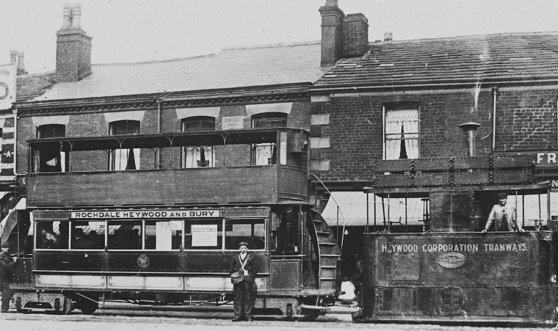
Heywood Corporation Tramways Steam Tram No 63, a Beyer Peacock-built Wilkinson engine of 1886, stands in what is probably Heywood Market Place — photo undated, but almost certainly taken in 1905. Photo courtesy of the National Tramway Museum.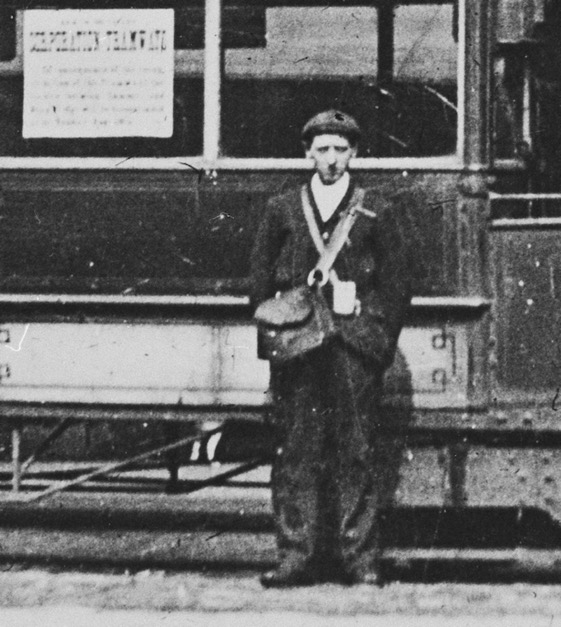
An enlargement of the above photograph showing the conductor, who is clearly wearing informal attire, with a money satchel and a ticket rack/punch.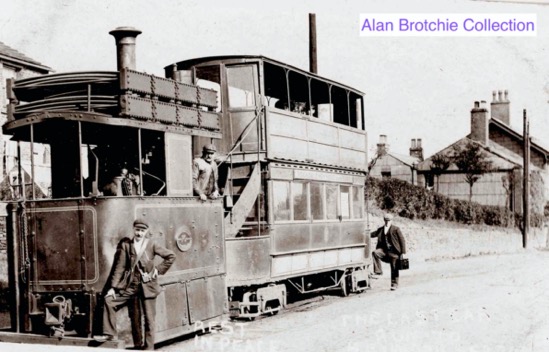
Engine No 70 (a Beyer Peacock product of 1886) stands with an unidentified trailer at the Heywood Cemetery terminus, which was near the eastern municipal boundary. Although undated, the photograph was probably taken in autumn 1904 or spring 1905 as there are leaves on the trees in the background.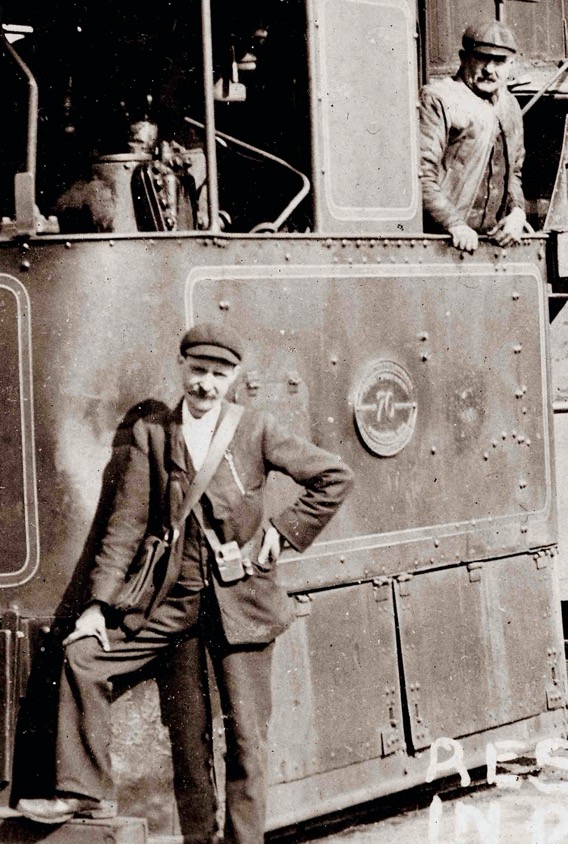
An enlargement of the above photograph showing the conductor and the driver.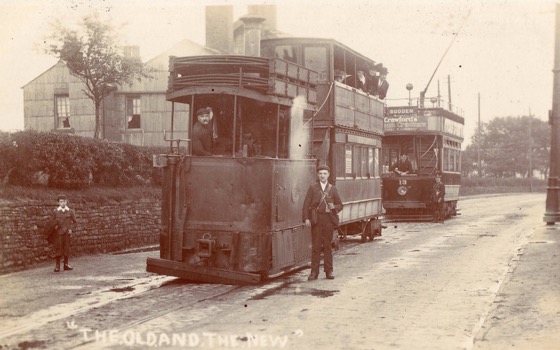
A classic 'Old & New' photograph, much loved of local photographers, who saw the commercial possibilities of capturing the switch to electric traction — photo undated, but probably taken in September 1905. Here we see a Beyer Peacock engine (possibly No 79) along with Rochdale Corporation Tramways rather more up-to-date No 13, at Heywood Cemetery terminus. Photo courtesy of the Richard Rosa Collection.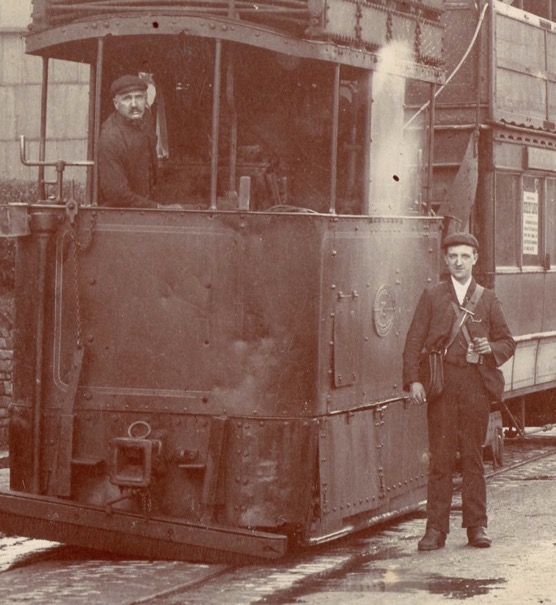
An enlargement of the above photograph showing the driver (in railway footplate-like attire) and the conductor (in informal attire, though smart enough). The latter would seem to be the same individual depicted in the first photograph above taken in Heywood Market Place.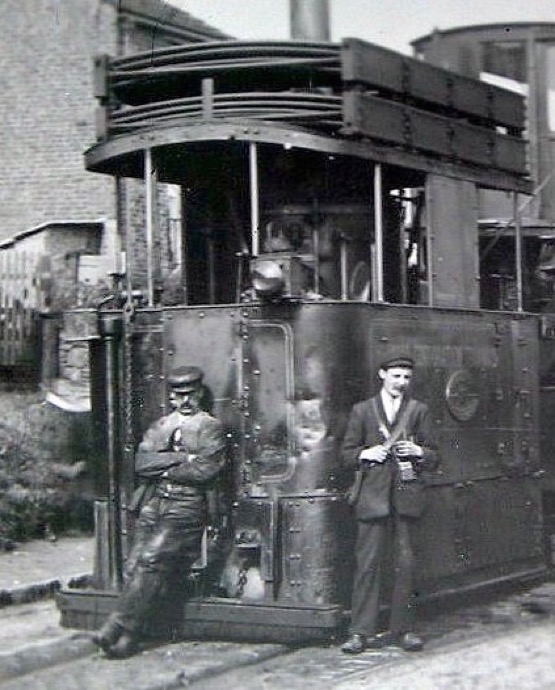
The driver of Wilkinson-patent locomotive No 81 (built by Beyer Peacock in 1886) leans nonchalantly against his engine — together with his conductor — at the Heywood Cemetery terminus, allegedly on the last day of operation, 20th September 1905. Both the driver and conductor are wearing informal attire without insignia of any kind, in continuance of the policy of the previous service providers, the BR&OSTCo (until 10th June 1904). Photo courtesy of the Tramways and Light Railway Society, with thanks to David Voice.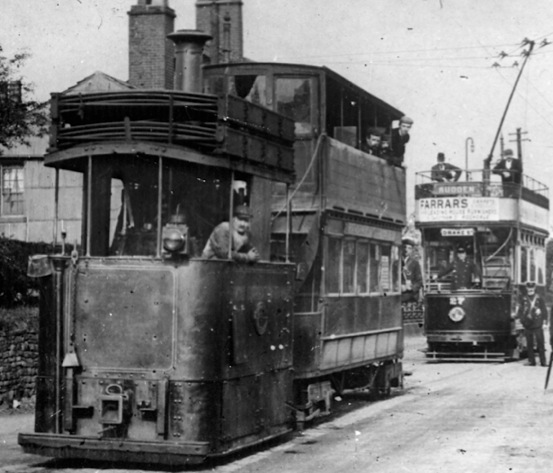
Another photograph of No 81 at the Heywood-Rochdale boundary, but this time of the opposite side of the engine, and again ostensibly taken on the last day of operation, 20th September 1905. The tramcar in the background is No 27 of Rochdale Corporation Tramways. Photo courtesy of the National Tramway Museum.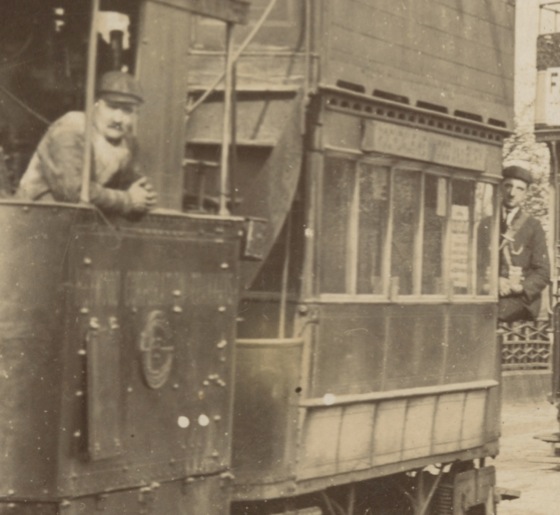
An enlargement of the above photograph showing the driver and the conductor. Given the strong facial resemblance, it is possible that the conductor in most of the photos above, is the same man.
Senior staff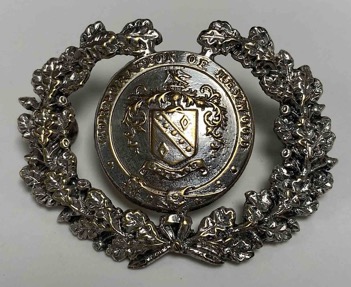
A Heywood Corporation municipal cap badge — nickel. Although this pattern of cap badge may indeed have been worn by Heywood tramway inspectors, there is currently no photographic evidence available that would either prove or refute this. Photo courtesy of the National Tramway Museum.